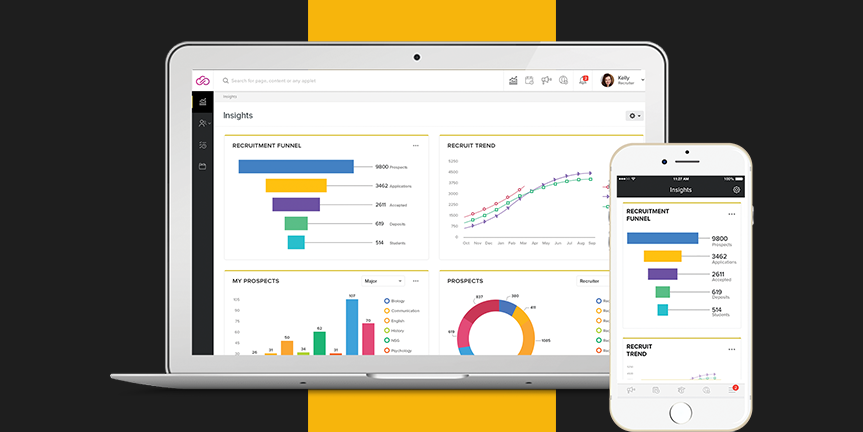The Use of Predictive Analytics in Higher Ed is Here to Stay
The opportunity to utilize predictive analytics in higher education was first documented in a scholarly article in 2001; in 2012 several articles hypothesized on how best to use data as leading indicators. Yet many college and university administrators are still cautious when it comes to implementing predictive analytics. Perhaps this is due to the lack of a critical mass of success stories. Maybe it’s because each institution’s data sets are vast, and newcomers to predictive analytics don’t know how to begin organizing them. Or perhaps the strategic value of using predictive analytics has not been thoroughly demonstrated by technology providers.
While there aren’t volumes of academic journals filled with predictive analytic success stories, there is vast use of these tools in daily life. If you’ve shopped online, you’ve seen the “people who purchased this item also viewed…” references. As you’ve scrolled through movie streaming sites, recommendations pop up noting titles from genres, actors and eras that match your interests. Viewing a home for sale online results in notifications of several others that have similar characteristics and are available. In each of these examples, your individual behavior– where and how you are viewing, scrolling and clicking -is meshed with collective behaviors, which result in the prediction and strong likelihood of your next action. That’s the power of predictive analytics.
Translating this back to post-secondary education, some early adopters have successfully utilized data to predict student behaviors and drive a variety of strategies. Georgia State University is widely heralded for its identification of 800 different success factors which have informed their retention, persistence and graduation strategies and results. Excelsior College tapped into its data to find at-risk students who were engaged with the school versus disconnected, to better focus on retention efforts for their adult learner-centric population. Other institutions have become very proactive in communicating with students based upon their outcomes in course selection, on-campus vs. off-campus housing choice, or financial standing. The use cases for predictive analytics in higher education have grown faster than the ability to consume and prepare strategies for them.
You may be looking to increase enrollment or decrease attrition, automate smart course registration or develop guided pathways. You want to go beyond triggering alerts to offer proactive, targeted assistance. The truth is, your technologies on campus likely have supported these tactics for years. However, using predictive analytics can turn said methods into powerful, personalized strategies for student and institutional success.
If you haven’t embraced analytics for predictive purposes where should you begin? By setting a few ground rules and goals.
- Be specific. Measuring for the sake of measuring can result in data inundation and a literal analysis paralysis. Instead, identify your institution’s greatest challenge and create a problem statement. Identifying the desired end state (e.g. ‘increased enrollment of adult learners in the online accounting program by 10% in the next two years’) helps you focus in on the data you’ll need to start measuring.
- Be inclusive. Institutions are filled with a plethora of data sources, from systems of record to ancillary systems and shadow databases. Likewise, many data experts work across the campus. Invite a variety of departmental representatives to join the problem-solving team. This way, planning discussions are rich and decision points more comprehensive.
- For best results, use five to ten years of data modeling. Using one or two years’ worth of data to create a predictive strategy lacks the historical depth that can better inform your approach. If there has been a marked shift in your student body or academic programs in the last three years, run at least five years of data to create your predictive model. If your institution profile has remained consistent for the last eight years, run ten years of data. The results will identify more mature predictors to then query against your current and future data.
- Align your analytics to your actions. Many times strategies are more espoused than enacted. Make sure you create a plan that not only leverages the data, but does so in a timely fashion and, just as importantly, in an actionable way. Then validate and adjust your data points– or your strategy – accordingly. This alignment is critical to your success.
Higher education has long recognized the value in collecting, processing and reviewing data for historical purposes. The notion of deriving “business intelligence” from data is a newer concept when juxtaposed against hundreds of years of providing post-secondary education. Administrators know the use of data is important in driving decisions, so why hesitate when it comes to using predictive analytics? As education technology vendors, perhaps we need to do a better job of helping institutions understand the explicit value and strategic impact of this tool. Predictive analytics, while seemingly anchored in your past, literally can change your future.
At Unifyed, we don’t need a crystal ball to know that predictive analytics are here to stay. We’re excited about helping your institution derive the greatest value from your data with our easy-to-use Unifyed Analytics platform. Our team is ready to help you identify the right data, at the right time, so that you can take action and make the best-informed decisions. Would you like to learn more about how we can do that? Schedule a demo with Unifyed today.

